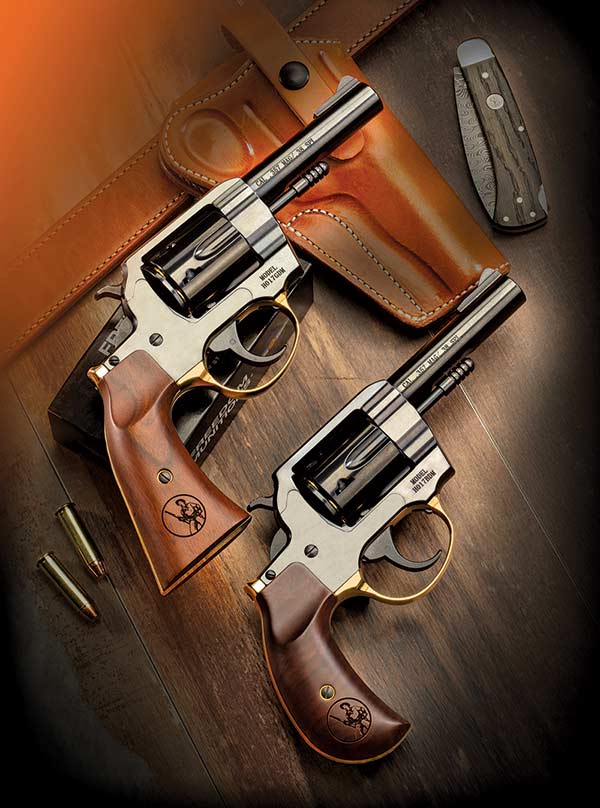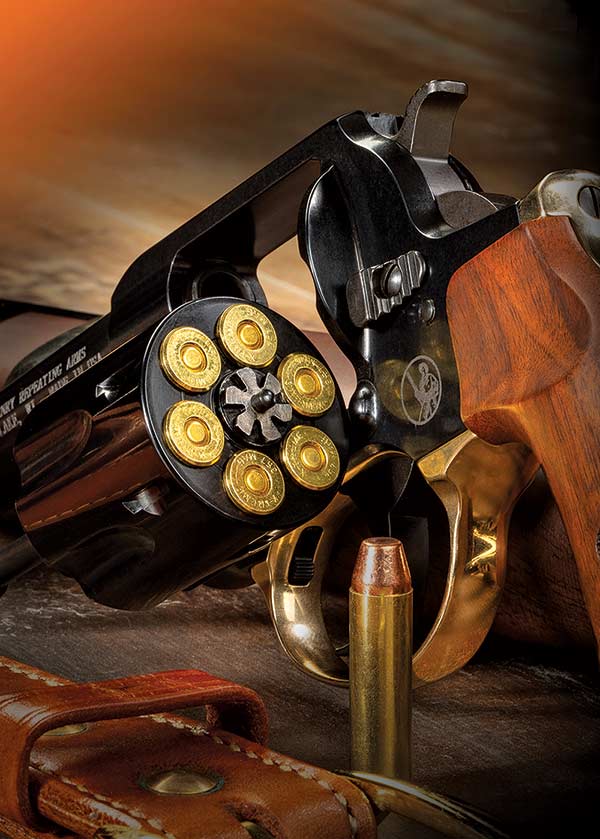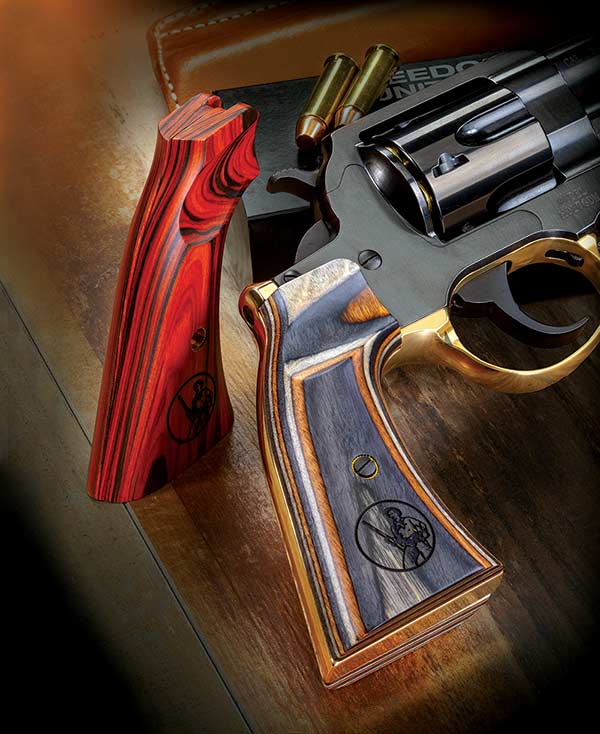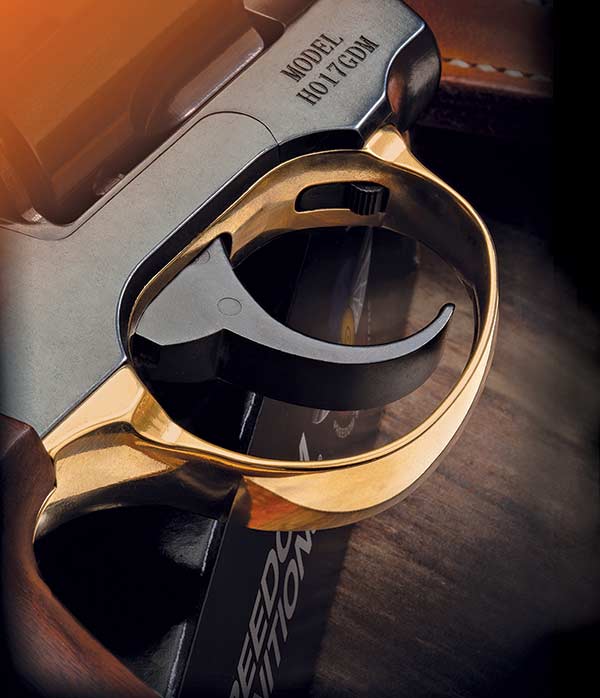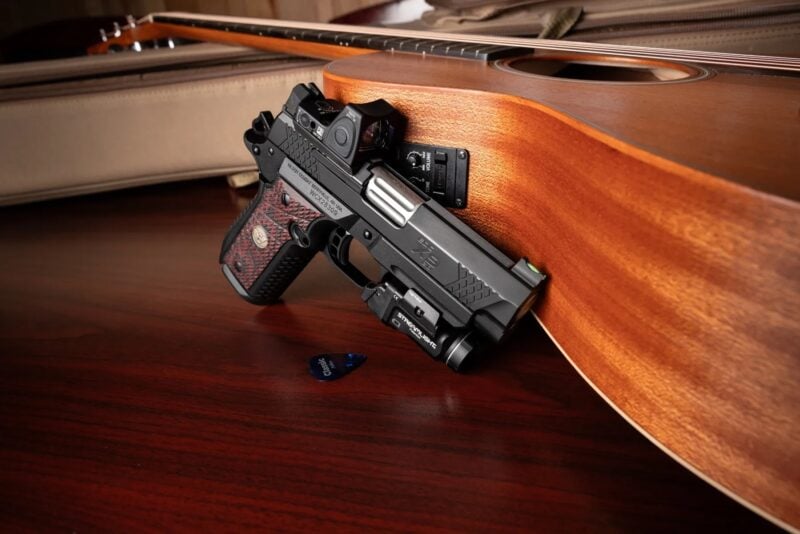Henry Big Boys: .357 Magnum
Classically Modern — With a Film Noir Flavor
In the early 1860s, the original Henry Rifle revolutionized warfare. A 16-shot in .44 RF, it proved a small handful of soldiers could win the day if deployed the right way. As one Southern officer commented: “It’s that damn Yankee rifle you load on Sunday and shoot all week.” The North was never able to procure enough Henry rifles to make a significant difference, but the design went on to help pioneers in the West, native Americans, soldiers, and just-plain settlers. It was the foundation for later lever-action rifle designs. It was also the name a young businessman would choose for his company — decades later.
In 1978, Anthony Imperator worked in his family’s gun shop in downtown Manhattan, of all places. Anthony had a passion for firearms, business — and America. He founded Henry, with his father Louis, in 1996 and, in March of ’97, shipped their first rifles. As other companies later began to push manufacturing off-shore, Anthony, according to the Henry website, “…doubled down on an obsessive focus on his company’s domestic production, authoring the company’s corporate motto ‘Made in America, or Not Made at All.’”
But to me, here’s the most important part about Anthony Imperato and the employees of Henry — they formed the charitable branch of Henry called “Guns For Great Causes.” Unlike many “donations” done in the industry, Henry commits 100% of the price of a gun sale in the Great Causes division to the charity. Henry has donated millions to the families of sick children, children’s hospitals, veteran organizations, first responder organizations, wildlife and habitat groups, 2nd Amendment groups and organizations promoting shooting sports of all sorts in America.
I’ve met Anthony and many members of the crew at Henry, and they are among the nicest people you’ll ever meet. Anthony’s passion for both the industry and his charities is obvious when you talk to him — and that makes reviewing a Henry firearm all the more fun. Now you know some history — so let’s talk guns.
Revolvers?
As many of you likely were, I was caught off-guard by the announcement of Henry’s new Big Boy .357 Magnum revolver design. I’ve admired Henry’s long guns of all types, but this one came clean out of the blue. Seeing the initial press release photos, I confess the design looked a bit unusual. I think I was expecting a classic single-action design, but the DA/SA swing-out cylinder revolver — with a polished brass frame, no less — floored me. To my eye, it looked a bit retro, like a Colt Official Police met a Ruger Speed Six — and the baby was now an adult. And I mean that with all due respect, honest. Sort of a “best of both worlds” situation. At first, I wasn’t sure I “got it,” but then the more I looked at the design and got my test guns, the more I understood what was going on. It’s a bit “steampunky” (look it up if you have to) and retro and modern all at the same time. The key to me would be if it worked.
Henry is producing two models, a more or less full grip frame version and a “Birdshead” frame; otherwise, they’re the same gun. There are a couple of stand-outs right off the bat. The gun ships with three front sights, so you can hopefully change them out to help zero for your favorite load. Henry is also offering factory grip options mirroring the stock grips but prettier. The grip frame contains a coil main spring and is in a sub-frame, a bit like a Ruger DA set-up. Being roughly GP-100 sized, most holsters fitting the Ruger seem to fit the Big Boy. K-Frame speedloaders also seem to fit just fine. That friendly Alaskan maker of fine leather, Diamond D, also offers a great field holster fitting perfectly. It could easily do double-duty as a CCW rig if you wanted to carry this 2-lb. hunk of steel and brass!
Gun Specifics
Okay, so if you have an S&W L-Frame or GP-100, you can get an idea of the general heft and feel. While it kinda’ looks like a pre-war Colt, it’s beefier and brawnier. I’m thinking that’s where the Big Boy moniker comes from. There’s no warning about “No Plus-P ammo,” and, as a matter of fact, they say you can fire any factory load you want. I’m sure they don’t mean anything silly here folks, but there’s a lotta’ steel here and trust me, you’ll wear yourself out long before the gun cries uncle. Both styles are .357, and I did find the ejector star barely got .38s out of the chambers so a snappy push on the rod is in order for ejecting.
You’ll note the little hump at the top of the backstrap. Shades of the S&W Schofield, but as funny as it looks, it does help to keep the gun settled into a firing grip. Plus, it adds to the retro look and makes me want to say, “Unhand her, you ruffian!” when I hold it out at arm’s length. While not overtly “heavy-barreled” with a rib on top like some designs, I’d definitely classify this as a heavy barrel. There’s also no shroud or front locking lug, but there is a detent ball there, locking into the frame. This set-up allows a very comfy end on the ejector rod, so feel free to pound away at it if you get a balky empty case refusing to extract.
Another thing about this “outside of the box” gun is the fact — wait for it — there’s a tiny button in front of the inside of the trigger guard with a big surprise going with it. Press it and wonder-of-wonders, the entire cylinder and crane slips niftily out of the front. What a delight when it comes to cleaning. The only other revolver I’ve seen do that is a $4,000 Korth, thank you very much, while the Big Boy is a distant $928 MSRP.
The frame is generally de-horned and nice to handle. The firing pin is in the frame, and the action has a transfer bar, so it’s safe to carry with six in spite of the fact some might cry and tear their hair at the thought of it. “Oh, the humanity …” Barrels, at least for now, are right at 4″ and the look reminds me of a “copper’s” revolver in a 1935 city police department. Maybe in a swivel holster.
There are no unsightly action locks or, praise be, lines of pressed-in instructions about having to read the manual and don’t shoot yourself in the foot, etc. Thank you, Henry, we’re adults here and appreciate you realizing that. The cylinder rotates counter-clockwise, and the chambers aren’t recessed, which doesn’t mean anything at all other than it’s easier to clean. In the old days of balloon head cases, one could let go now and again, and a recessed case head made sense. Today’s brass just doesn’t do that, so why bother? Besides, it also makes it easier to load the chambers since you don’t need to do the “run your thumb over the case heads” after loading to make sure they’re pushed into the recess — especially as things dirty-up.
The really fun part of this is the fact the action is very good. As in other things, it falls someplace between a Colt and a Ruger. I like the fact there are two distinct clicks as you pull the trigger in DA mode. The first is a light “snick” as the cylinder locking bolt gently lands against the cylinder as it turns. The second is the bolt settling home in a notch just prior to the DA sear releasing. You can stage this trigger beautifully while you learn to shoot in DA mode if you don’t already know how. If I decide to keep one of these guns, I definitely plan on taking it apart and doing a light action job just to smooth things up even more. But they are exceptionally good-to-go right out of the box. Mine test out at around 10 lbs. DA and 3.8 to 4 lbs. SA, give or take. The SA press is very smooth with no grit, just a nice surprise break.
Shooting
More out of fun than anything, I asked for one of Henry’s Big Boy Classic .357 lever guns (20″ barrel) to go along with things. I was mostly curious to see how velocities compared from the long and short barrels, as I’m sure you are too. It’s a topic of interest that never seems to get stale. I fired seven .38 Special loads and six .357 loads through the revolvers and the rifle over a chronograph. I also targeted three of the .38 loads and two of the .357 loads as it was pretty cold out on the test day, and I can get a bit sissified when it comes to that.
There were no surprises with velocities, really. The hottest .38 load was a Buffalo Bore 158 SWCHP lead load at 1,126 fps from the sixguns, and 1,445 out of the rifle, winning both slots. But an honorable mention goes to the Black Hills HoneyBadger defensive load, a solid copper fluted bullet. It clocked 1,089 out of the Big Boy revolvers and a pretty darn good 1,388 out of the rifle. The rifle-length barrel seemed to coax another 200 fps or so out of most loads. Self-defense? You bet, you’d have the best of both worlds with a long and a short gun.
In the .357, the velocity awards go to the Buffalo Bore 125-grain JHP at a blistering 1,526 out of the pistol and 2,289 out of the rifle. Is there a trend here with Buffalo Bore ammo? Running a very close second was the Black Hills HoneyBadger, a very nasty-looking fluted 127-grain bullet running at 1,389 from a Big Boy and 1,995 from the rifle. Zowie! I honestly had no idea we could get those velocities out of mainstream .357 ammo. In the husky Big Boy revolvers, recoil of the heavier loads, while attention-getting, were nonetheless manageable. I wouldn’t make a habit of it, though. The heavy rifle made shooting any of this sheer delight. The rifle barrel delivered up to 500 fps or more from most loads.
I used good old Black Hills 148-grain target wadcutters (685 fps out of the revolver, by the way) and really settled in at 25 yards for targeting, using both guns. I applied my “Eyepal” aperture patch to my shooting glasses to sharpen the sights and, after firing some warm-ups, found I could get 1.5″ if I really watched the press. The smooth-faced trigger helps that. Most loads hovered in the 1.75″ to 2.8″ range, give or take a tad. The challenge is the “too-small” rear notch (at least to me). I called upon 55 years of shooting DA revolvers to get this all right, but for the life of me, I don’t know why a good, raised fixed rear (like on any CCW auto today) wouldn’t work much better. I’d be willing to compromise my need for an old-timey look for a better sight picture. I install the Cylinder & Slide fixed rear on my revolver builds and will do the same on the Big Boy if I keep one. I’ll keep you posted.
The Winner Is?
Both guns are good, maybe even great guns. I personally prefer the full-size grip over the bird’s head, but your results may vary. This is a brawny, feature-rich, honest sixgun, built to shoot anything you have the guts to shoot out of it. It’s plenty accurate, was dead-nuts reliable over several hundred rounds of testing, looks good and shows excellent workmanship and finish. Indiana Jones should have had one of these in his holster, rather than that 1917 he had. Oh, there’s that lifetime guarantee, too, by the way.
Henry is in the business of helping people. From their employees and their families to those thousands outside who are often in need, Henry has delivered help with no questions asked. All of which, if you ask me, helps me to look even more favorably on Henry’s many products. If you own a Henry you not only get a good gun, you directly aid Henry as they support all those worthy programs. And that’s what we all like to do, isn’t it? Anthony Imperato is a philanthropist first, I think, and a gun maker second.
For more info: HenryUSA.com, EyepalUSA.com

